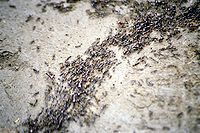
Photo from wikipedia
Complex service robotics scenarios entail unpredictable task appearance both in space and time. This requires robots to continuously relocate and imposes a trade-off between motion costs and efficiency in task… Click to show full abstract
Complex service robotics scenarios entail unpredictable task appearance both in space and time. This requires robots to continuously relocate and imposes a trade-off between motion costs and efficiency in task execution. In such scenarios, multi-robot systems and even swarms of robots can be exploited to service different areas in parallel. An efficient deployment needs to continuously determine the best allocation according to the actual service needs, while also taking relocation costs into account when such allocation must be modified. For large scale problems, centrally predicting optimal allocations and movement paths for each robot quickly becomes infeasible. Instead, decentralized solutions are needed that allow the robotic system to self-organize and adaptively respond to the task demands. In this paper, we propose a distributed and asynchronous approach to simultaneous task assignment and path planning for robot swarms, which combines a bio-inspired collective decision-making process for the allocation of robots to areas to be serviced, and a search-based path planning approach for the actual routing of robots towards tasks to be executed. Task allocation exploits a hierarchical representation of the workspace, supporting the robot deployment to the areas that mostly require service. We investigate four realistic environments of increasing complexity, where each task requires a robot to reach a location and work for a specific amount of time. The proposed approach improves over two different baseline algorithms in specific settings with statistical significance, while showing consistently good results overall. Moreover, the proposed solution is robust to limited communication and robot failures.
Journal Title: Applied Sciences
Year Published: 2021
Link to full text (if available)
Share on Social Media: Sign Up to like & get
recommendations!